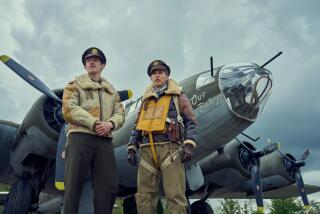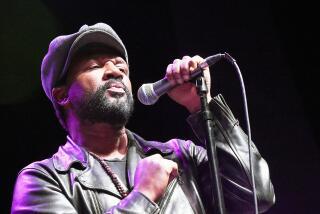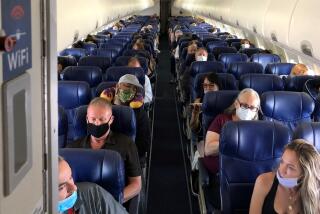Easy-to-Spot Air Security Might Be Easy Target
- Share via
WASHINGTON — As they settled into first class on American Airlines Flight 1438 from Chicago to Miami, they were supposed to be the last line of defense against terrorists -- two highly trained U.S. air marshals who would sit unnoticed among the ordinary travelers but spring into action at the first sign of trouble.
Imagine their chagrin when a fellow passenger coming down the aisle suddenly boomed out, “Oh, I see we have air marshals on board!”
The incident, detailed in an intelligence brief, is an example of something that happens all too often, marshals say. The element of surprise may be crucial to their mission, but it turns out they’re “as easy to identify as a uniformed police officer,” the Federal Law Enforcement Officers Assn. said in a complaint to Congress.
The problem is not security leaks. It’s the clothes.
In an era when “dressing down” is the traveler’s creed, air marshals must show up in jackets and ties, hair cut short, bodies buffed, shoes shined.
Jack Webb would be proud, but the marshals say they stand out like shampooed show dogs among the pound pups.
And the tipoff provided by their appearance is magnified by a set of boarding procedures that make them conspicuous.
Since they’re armed, the marshals can’t go through the initial security screening with the rest of the passengers. Instead using the entry points set aside for airport employees, the marshals often must go through the “exit” lanes -- marching against the flow of arriving passengers, at times in full view of travelers.
“They lose the advantage” of being undercover, said John Amat, a spokesman for the marshals within the federal law officers group.
Officials with the Federal Air Marshal Service, however, defended their sartorial standards.
“Professional demeanor, attire and attitude gain respect,” spokesman David M. Adams said. “If a guy pulls out a gun and he’s got a tattoo on his arm and [is wearing] shorts, I’m going to question whether he’s a law enforcement officer.”
As for the boarding procedures, Adams said, the agency is working to address the problems. Air marshals “are not undercover like Serpico,” he added, referring to the legendary New York detective. “The director refers to them as ‘discreet.’ ”
The air marshal service has grown from about 30 officers at the time of the Sept. 11 terrorist attacks to several thousand today, operating under a $600-million annual budget.
With the expansion has come an infusion of federal law enforcement culture. The director of the air marshals, Thomas D. Quinn, who took over in January 2002, spent 20 years with the Secret Service.
“Secret Service people are notoriously known for being snappy dressers,” said Capt. Steve Luckey, security chairman for the Air Line Pilots Assn.
And it was after Quinn took over, marshals said, that the strict rules on dress and grooming were instituted, including a ban on beards, long hair and jeans.
But today’s airliner is a come-as-you-are environment. Even “if you go in first class, you see the whole gamut,” Luckey said, from people in cut-off jeans to those in suit and tie. “I think you can go overboard with the professionalism.... The mission dictates flexibility and some relaxed dress standards.”
Many marshals interviewed -- who requested anonymity because they are not allowed to talk to the media -- agree.
What makes them uneasy is the prospect of being spotted by terrorists and disabled or killed before they could react.
“This is what I foresee,” said one marshal, a two-year veteran. “Two of us get on the plane and we’ve been under surveillance the whole time. There’s a minimum of four bad guys.... My partner goes to the bathroom and they come after me with a sharp pen, stab me in the neck or in the brain and take my weapon,” he continued. “When my partner comes out, they shoot him. Then they’ve got 80 rounds of ammunition and two weapons.”
Adams called such a scenario “highly unlikely.”
Yet a congressional General Accounting Office study of a two-year period from 2001 to 2003 found an average of about one case a week in which marshals reported their cover was blown.
The passenger on American Flight 1438 told the marshals “he picked them out because of their attire and the fact that they were on board before the other passengers,” an agency report on the Nov. 15, 2003 incident said. The report did not say whether the government took action against the man, although others who have outed air marshals have been prosecuted.
One marshal with previous military and law enforcement experience said that “a bad guy on a plane can quickly narrow the pool of potential marshals. They’re not wearing jeans, they’re not wearing cargo pants.... There will not be an air marshal who is unshaven. You eliminate the unknown element.”
Additional clues to their identity can be gleaned by observing airport check-in and boarding, several marshals said.
At the ticket counter, marshals must present an official leather credential case that is much bigger than a driver’s license and looks different than a passport.
“You can stand 20 feet away from the ticket counter and see it,” said the marshal with military experience. Ticket agents sometimes hold it up to the light to study the hologram on the picture, he added.
After they get their tickets, marshals head for the boarding gate. At their home airports, they can use a special access card to bypass the security checkpoint. But at other airports, they must go through the passenger exit lane.
“Everybody sees you standing there,” one marshal said. “Everybody sees you show your ID. They see you are being escorted through an exit lane, bypassing security.”
At the boarding gate, the marshals must again show their credentials to the airline agent. Then, because marshals have to brief flight crews in person, at least one team member has to board before the other passengers. That often takes place in full view.
“You see physically fit men in their mid-30s getting on an airplane early, and you know they’re not doing that because they need more time to get down the jet way,” said Patricia Friend, president of the Assn. of Flight Attendants.
The marshals have petitioned Congress for help in changing the rules. Several lawmakers are following up on the complaints. Among them is Sen. Herbert H. Kohl (D-Wis.), who talked with Quinn about the boarding procedures. And Rep. Peter DeFazio (D-Ore.) has asked the General Accounting Office to take another in-depth look at the agency. DeFazio is the ranking Democrat on the House aviation subcommittee.
Changes would largely be a matter of administrative action, but congressional pressure could force the issue.
In the meantime, some air marshals have found ways to adapt. The marshal with military experience said he deliberately acts as the more visible member of his team. He walks down the jet way before the passengers. If someone stares at him, he stares back. By becoming the focus of attention, he figures he’s helping protect his partner’s anonymity.
“If they come after me first, he might be able to save my bacon,” the marshal. “At least one guy may be able to do something to defend the aircraft.”
*
(Begin Text of Infobox)
Air marshals
Gender: 96% male; 4% female.
Race and ethnicity: 73% white; 13% Latino; 9% African American; 2% Asian American; 1% Native American; 1% other or not reported.
Age: 22% 30 and younger; 65% 31 to 40; 10% 41 to 50; 4% 51 and older.
Dress: Suit and tie or sport coat, collared shirt, dress slacks and dress shoes. Equivalent attire is required for female air marshals.
*
Sources: General Accounting Office, Los Angeles Times
*
Note: Totals may not add to 100% because of rounding.
*
Los Angeles Times
More to Read
Sign up for Essential California
The most important California stories and recommendations in your inbox every morning.
You may occasionally receive promotional content from the Los Angeles Times.










